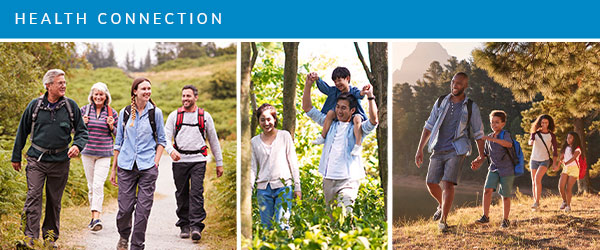Health Connection - April 2022

Our New VELYS™ Robot: The Next Big Thing in Knee Replacement

If you need a new knee, there’s never been a better time to have joint replacement surgery at MarinHealth Medical Center. We’ve expanded our partnership with UCSF Health to add more orthopedic surgeons to our expert team. With our expanded roster, we can now treat the full range of orthopedic issues, virtually from head to toe. We have a new hospital building that’s home to state-of-the-art operating rooms. And now, thanks to a generous gift from the Lindskog Foundation, we are one of the first hospitals in the North Bay to offer patients knee replacement surgery with the VELYS™ Robotic-Assisted Knee Replacement Solution.
While robotic knee replacement has been around for a decade, this technology is more advanced than previous systems, which used a 15-year-old implant. The VELYS™ robot uses the DePuy ATTUNE® Knee System, a modern, customizable implant that is exceptionally stable and durable and provides excellent ease of motion. Another considerable advantage the VELYS™ robot has over earlier systems is that it does not require advance MRIs or CT-scans, which insurers do not consider medically necessary for knee replacement surgery and are reluctant to approve. In addition, it’s always a good idea to avoid exposing patients to radiation unless medically necessary.
Instead of relying on preoperative imaging, VELYS™ robotic knee replacement is planned in real time, using the robot’s software to assess the anatomy of the patient’s natural joint. Every patient, and every knee, is different. The VELYS™ robot helps surgeons tailor surgery to each person’s anatomy for optimum alignment, joint stability, and mobility. The technology determines the ideal positioning of the implant, ensuring the best possible fit in the surrounding soft tissue, and customizing alignment and balance through a complete range of motion.
The robot enhances precision--not just in planning but during the procedure itself. The surgeon operates using a surgical saw attached to a robotic arm, for exceptionally accurate cuts. During the procedure, ADAPTIVE TRACKING™, the robot camera’s high-speed optical tracking system, takes 300 images per second, capturing the surgeon’s slightest movement for remarkably detailed imaging. At the completion of surgery, the joint’s position is reassessed one final time in case any tweaks are needed before the new knee is permanently implanted.
As remarkable as the VELYS™ robot is, it’s just a tool without an experienced and highly capable surgeon at the controls. Furthermore, not every patient is a good candidate for VELYS™ robotic knee replacement. For example, in situations where the patient’s ligaments are damaged or the surgeon is revising or redoing a previous knee replacement, manual surgery is usually the best option. Your new knee is going to be a part of you for decades –- hopefully for the rest of your life. As a prospective patient, your first and most important task is choosing the surgeon, not the procedure. For the North Bay’s most accomplished joint replacement experts, MarinHealth is the place to start.
The Five-fecta of Metabolic Syndrome
Metabolic syndrome is not an actual disease: It’s a “five-fecta” of conditions that add up to a strong risk of developing heart disease, diabetes, stroke, atherosclerosis (fatty buildups in artery walls), and other health issues. Each of the conditions that make up metabolic syndrome is an individual risk factor for cardiovascular disease, the likelihood of a serious health condition increases with the more risk factors you have. To receive a diagnosis of metabolic syndrome, you need to have at least three of the following:
- Elevated blood sugar
- Low levels of HDL cholesterol (the “good” cholesterol)
- High levels of triglycerides
- An “apple-shaped” body, indicative of excess visceral fat, with a waist circumference of more than 35 or more inches for women and 40 inches or more for men
- High blood pressure
Metabolic syndrome is linked to insulin resistance, the main symptom of prediabetes. Normally, your pancreas secretes the hormone insulin to break down the food you eat and allow your cells to process glucose (sugar) for your body to use as fuel. If your cells “resist” the insulin, they don’t absorb as much of the glucose and your blood sugar goes up. This triggers your pancreas to churn out increasing amounts of insulin in an attempt to lower your blood sugar. Without appropriate lifestyle changes and blood sugar monitoring, people with prediabetes eventually develop diabetes. Diabetes increases the risk of heart disease in several ways:
- Over time, high blood sugar damages the blood vessels and the nerves that control your heart.
- Diabetes is often associated with high blood pressure, which damages artery walls. Having both high blood pressure and diabetes greatly increases your risk for heart disease.
- Diabetes is often linked to an excess of LDL (“bad”) cholesterol, high triglycerides (a type of fat in your blood), and low HDL (“good”) cholesterol. This combination promotes the development of plaque in the arteries.
Up to one-third of US adults are either diagnosed or not yet diagnosed with metabolic syndrome. Other than the thick waist, most of the disorders listed above do not have obvious signs or symptoms, so people won’t necessarily be diagnosed unless they see a doctor — a good reason to have regular checkups. Once the condition has progressed you may see symptoms of untreated diabetes — increased thirst and urination, fatigue, and blurred vision.
Risk Factors for Metabolic Syndrome
- Age. Your risk of metabolic syndrome increases with age
- Ethnicity. Although no ethnic group is immune, people with Hispanic ancestry, women, have the greatest risk of developing metabolic syndrome
- Obesity. Being overweight, especially if you have a lot of belly fat, is a sign of unhealthy visceral fat deep in the abdomen
- A sedentary lifestyle. People with metabolic syndrome spend a lot of time sitting and don’t tend to exercise
- Diabetes. People with metabolic syndrome often have a family history of type 2 diabetes. Women who develop gestational diabetes during pregnancy have an elevated risk of developing diabetes later in life
- Other diseases. Nonalcoholic fatty liver disease, polycystic ovarian syndrome, and sleep apnea are all frequently associated with metabolic syndrome
Prevention is Key
A lifelong commitment to a healthy lifestyle can help prevent the conditions that cause metabolic syndrome. You are much less likely to develop it if you follow these commonsense recommendations:
- Get at least 30 minutes of physical activity most days
- Follow the Mediterranean diet: Eat plenty of vegetables, fruits, lean protein and whole grains and cook with olive oil instead of butter or margarine.
- Reduce your salt intake
- Maintain a healthy weight
- Avoid all tobacco products — if you smoke, QUIT
Foot Care for People with Diabetes

The human foot is a marvel of natural engineering made up of 26 bones, 33 joints, 107 ligaments, and 19 muscles and tendons. Your feet are literally your body’s foundation, designed to support your weight, help you balance, and withstand the stress of every step you take. That’s 3,000-4,000 steps a day for the average American, so it isn’t surprising that 75% of us will experience foot or ankle problems at some point in our lives.
No matter what ails your feet, from ingrown toenails and bunions, to osteoarthritis, nerve damage, and broken bones, the first person to call is a podiatrist. While most of us will only see a podiatrist when something goes wrong, for people with diabetes, this doctor is an essential part of their regular care team.
About 25% of patients with diabetes will eventually develop a foot ulcer. Some of those ulcers do not heal properly and 25% of those eventually require amputation. In the U.S., 60% of non-trauma related lower limb amputations -– roughly 73,000 surgeries -– are performed on people with diabetes every year. Even more troubling, amputation rates are going up with the rise in diabetes cases. In California, 1 out of 3 adults either has pre-diabetes or diabetes, and we are seeing amputation rates rising in most California counties.
Common Foot Conditions in People with Diabetes
People with poorly managed type 1 or type 2 diabetes are susceptible to diabetes-related foot issues:
- Peripheral arterial disease is reduced blood flow in the feet and lower extremities, causing constant foot pain and in severe cases foot blistering and gangrene
- Peripheral neuropathy is nerve damage that causes loss of sensation in the extremities as well as numbness, burning, tingling, cramping, and balance issues
In peripheral neuropathy, the pain receptors to the bottom of your feet lose sensitivity. Over time, you can no longer feel the bottom of your feet when you walk. You may develop blisters and foot injuries over the course of the day and not even notice. Because diabetes often weakens the immune system, these injuries have a higher likelihood of turning into persistent infections and ulcers.
MarinHealth’s® Braden Diabetes Center offers specialized diabetic foot care and regular foot checkups. Podiatrists specialize in limb preservation as part of their training and routinely address the barriers to healing, such as poor blood flow, increased pedal pressure from bony prominences, and superficial versus deep infections.
Foot Protection and Ulcer Prevention Tips for People with Diabetes
- Check your feet daily. If you have mobility issues and can’t see the bottoms of your feet, use a mirror, or get help from a family member. Look for cuts, irritation, sores, blisters, calluses, corns, and changes to skin or toenails. Call your podiatrist if you see anything unusual. DO NOT try to treat anything yourself. Using over the counter products to remove corns or calluses can burn the skin.
- Wash your feet in warm water every day. Don’t use hot water, and don’t soak your feet. Dry them completely and apply lotion, but not between your toes, which can lead to infection.
- NEVER go barefoot, even indoors. Check the linings of your shoes for pebbles. Wear shoes that fit well, breaking in new shoes for an hour or so a day until they are completely comfortable. Always wear socks or foot liners.
- Keep your toenails well-trimmed.
- Get your feet checked at EVERY visit with your endocrinologist or PCP, whoever is helping you manage your diabetes.
- Get a complete exam from your podiatrist AT LEAST once a year, more often if you have nerve damage. This includes checking your feet for feeling and blood flow.
- Encourage blood flow by putting your feet up when you’re sitting down and periodically wiggling your toes throughout the day. Walk, ride a bike, or swim to maintain your health and circulation.
- Wear white socks -– any blood or drainage will be easily noticeable. Take that as a nudge to make an appointment to see your podiatrist right away.
The good news is that 80 – 90% of diabetes-related amputations can be prevented if the problem is diagnosed early enough! If you experience any of the below symptoms, see your regular doctor or a podiatrist right away:
- Leg pain or cramping in the buttocks, thighs, or calves during physical activity
- Foot pain, tingling, or burning
- Numbness and/or the inability to feel heat or cold
- A change in the shape, color, or temperature of your feet
- Hair loss on your toes, feet, and lower legs
- Dry, cracked skin on your feet
- Thickened, yellow toenails
- Fungul infections such as athlete’s foot between your toes
- Any blister, sore, ulcer, corn, or ingrown toenail
If you have type 1 or type 2 diabetes and would like to make a foot care appointment at the Braden Diabetes Center, call 1-415-925-7370 and ask to be scheduled with a podiatrist.
Walk This Way: Tips for a Safe Hike
With the return of warm weather, many of us are eager to hit the trails. Following a few safety tips will help ensure many happy returns to your favorite parks and country roads. The following hints are for day-hikers. While they also apply to backpackers planning to camp in the wilderness, adventurous treks take more training, preparation, and special equipment.
Plan Your Hike
Trails are typically rated easy, moderate, or hard. Don’t overestimate your abilities, especially if you are a novice hiker. Newbies should consider taking a two- or three-hour practice hike to get to know what they can handle physically. You’re likely to be out of cell range, so always let someone at home know where you are going and when you plan to be back. It’s preferable to hike with a buddy.
Be Prepared for the Weather
The Bay Area is famous for its microclimates. Pay attention to the weather forecast for your specific destination and dress in layers.
Be Nice to Your Feet
Invest in a sturdy pair of hiking shoes or boots with good arch support and a tread on the sole that will keep you from slipping. Sporting goods store personnel can help you make a sensible choice. Avoid cotton socks which retain moisture. Wool socks are best for hiking.
Bring Poles
While you don’t necessarily need poles for a flat hike, you’ll want them to tackle big hills. They make the uphill trek easier and steady you on the way back down. Be sure to use your poles properly. You can find instructional videos on YouTube.
Stay on the Trail
In addition to increasing your chance of getting lost, walking off trail endangers delicate habitats, interferes with their restoration, and erodes hillsides.
Protect Yourself from the Sun
Hike in the early morning or late afternoon to avoid peak hours of sun and heat. Many of our local trails go through grassy hills with little shade. Planning a four-hour hike through this kind of terrain in hot weather is not a good idea, even for experienced hikers. Always wear sunblock of SPF 30 or more and reapply as needed. If you hike a lot, you may want to invest in clothing made from sun-protective fabric. Wear sunglasses and a wide-brimmed hat to protect your face, neck, and eyes. Stay hydrated and take your breaks in the shade.
Bring Plenty of Water
Carry a minimum of a quart of water for every two hours you plan to hike. Don’t drink from streams -- the water could make you sick even if it appears sparkling and clear.
Know the Signs of Dehydration, Heat Exhaustion, and Heat Stroke
Both heat exhaustion and heat stroke are serious conditions. Heat exhaustion happens when dehydration is combined with extended exposure to hot weather. Warning signs include:
- Heavy sweating
- Paleness
- Muscle cramps
- Tiredness
- Weakness
- Dizziness
- Headache
- Nausea
- Fainting
Ideally, one experiencing these symptoms would drink chilled beverages, take a cool shower, and seek an air-conditioned environment -– none of which is easy to do in the wilderness. The next best thing is to seek shade, drink liquids, pour water on your head and body, and loosen tight clothing. The goal is to keep heat exhaustion from progressing to heat stroke, which is potentially fatal. In heat stroke, the body can no longer regulate its temperature and the person’s internal temperature reaches 103 degrees.
Look Out for Dangerous Critters!
- Mountain lions are rarely seen and more likely to attack deer than humans. Still, they are dangerous. If you see one, stay calm and keep your distance. Stand your ground or slowly back away without turning your back on the lion. Don’t crouch, bend over, or run.
- Rattlesnakes come out and sun themselves when the weather warms up, and they don’t care if they’re in the middle of a hiking trail. That’s why you should always look where you are stepping, especially as the weather gets warm. If you see a rattler, maintain at least 6 feet of distance. Before you step over or sit on a log, look to see what’s on the other side. Be careful climbing rocks. If you hear that distinct rattle, freeze, and look all around you to spot the snake.
- Wild Boars will charge and bite if they feel threatened. If you see a wild boar, slowly back away and don’t provoke it with sudden gestures or noise.
- Bear sightings have been more frequent in the Bay Area in recent years. If you encounter a bear, stay still and slowly wave your arms above your head. Remain calm and speak in low tones. Do not try to imitate a bear roar and avoid making any kind of high-pitched sound.
- Ticks can be found wherever there are deer -– pretty much everywhere in the North Bay. Stick to the middle of the trail to avoid them. Use insect repellent. Avoid wearing shorts and tuck your pants into your socks. Do a tick check at the end of your hike. If you’re hiking with a buddy, check each other’s backs and necks. When you get home, examine your gear to make sure you didn’t bring any of the little blood suckers home.
Steer Clear of Poison Oak
Poison oak is great at camouflage. It can grow as tall as a large bush, wrap around a tree trunk like a vine, or mix in with wild blackberries. The leaves can be rounded or resemble oak leaves. They are often shiny but not always. In the winter, poison oak can look like a seemingly harmless bare twig, but it will still give you a rash if you touch it. The general rule is “Leaves of three, let it be.”
Carry a First Aid Kit
You can buy a small pre-packed first aid kit online or at the drug store. Add packets of IVY-X to quickly wipe the toxic oil off if you accidentally touch poison oak. Be sure you have sunblock and chap stick or lip balm with you!

